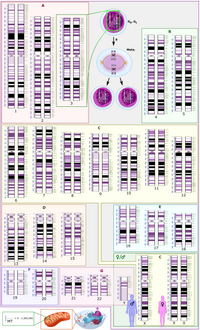
Photo from wikipedia
Human papillomavirus (HPV) types 16, 18 and 58 are ranked the top three high-risk HPV types for cervical intraepithelial neoplasia (CIN) and invasive carcinoma. We aimed to evaluate the diversity… Click to show full abstract
Human papillomavirus (HPV) types 16, 18 and 58 are ranked the top three high-risk HPV types for cervical intraepithelial neoplasia (CIN) and invasive carcinoma. We aimed to evaluate the diversity of HPV16, HPV18, and HPV58 genetic variants by HPV capture technology combined with next generation sequencing. 295, 73, and 148 variations were observed in 51 HPV16, 7 HPV18, and 11 HPV58 genomes, respectively. HPV16 isolates were predominantly of the A variant lineage, and sublineage A4 (Asian) was the most common. However, there were no significant differences in the distribution of HPV16 A1–3 and A4 variants between CIN1-, CIN2/3, and cervical cancer groups. The 7 HPV18 genomes were assigned to the A3/A4 and A1 sublineages. Of the 11 HPV58 genomes, the most predominant variant sublineages were A2, followed by A1 and B2. The majority of HPV16/18 samples containing contiguous genomic deletions were found to harbor HPV integration. Some T-cell epitope sequences in HPV16 E6 and E7 showed considerable divergence from the prototype NC_001526, suggesting their importance in immunotherapy of HPV-associated carcinomas. In conclusion, sequence diversity and phylogenies of HPV16, 18, and 58 provide the basis for future studies of discrete viral evolution, epidemiology, pathogenicity, and the differences in response to vaccines.
Journal Title: Scientific Reports
Year Published: 2017
Link to full text (if available)
Share on Social Media: Sign Up to like & get
recommendations!